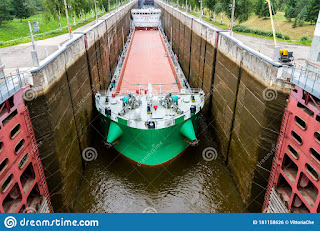What is a canal?
Canal:- An artificial waterway constructed to allow the passage of boats and ships or on the land to convey water for irrigation.
World famous canals
Panama Canal
Length: 82 km Width: 150m Depth: 12m
The man-made 82 km (50.9 miles) Panama Canal steered transportation and travel by interfacing the Atlantic and Pacific seas across a tight segment of land in Panama. Finished in 1914, the channel empowers boats to go through a progression of locks to get from one side to the next and kills the requirement for boats to take the significantly longer and perilous course around the tip of South America. Today over 14,000 boats pass the Panama Canal consistently.
Suez Canal
Length: 193 km Width: 205m Depth: 20m
Opened in November 1869, the 193.30 km (120 miles)- length Suez Canal is a fake ocean-level stream situated in Egypt. Connecting the Mediterranean Sea with the Gulf of Suez, the Suez Canal is a very pivotal transportation waterway in the planet's sea area as it is one of the most vigorously involved delivery courses in the world. The trench, which isolates Asia from the African landmass, gives the briefest sea course among Europe and the locales that share a line with the Indian Ocean and the Western Pacific Ocean.
Beijing-Hangzhou Grand Canal
Length: 1,782 km Width: 40 to 350 m Depth: 2-3m
The Beijing-Hangzhou Grand Canal is the longest and most seasoned waterway on the planet. It associates China's Yellow River and Yangtze River. The trench goes through numerous territories in the nation and is associated with numerous waterways. Associating northern and southern China, the waterway assumes a significant part in freight transportation. Its commitment to the country's economy is perfect. The Grand Canal, worked in 468 BC, is a UNESCO World Heritage Site.
The White Sea-Baltic Canal
Length: 227km Width: 36m Depth 4m
The White Sea-Baltic Canal is situated in a Russian-based channel that was built somewhere in the range of 1930 and 1933. It interfaces the White sea to Lake Onega as it joins the Volga-Baltic Waterway. Out of the 227 kilometers long, 36meters are counterfeit
Length: 6 Km Width: 25m Depth: 8m
Corinth Canal
It interfaces the Gulf of Corinth of the Ionian Sea and the Saronic Gulf of the Aegean Sea. The channel goes through the limited Isthmus of Corinth. What's more, isolates the Peloponnese from the central area of Greece. Transport is of no significance because of its width of just 21 meters. The channel associates the Gulf of Corinth with the Saronic Gulf in the Aegean Sea. Development of the trench started in 1881 and finished in 1893. It associates the Gulf of Corinth and the Saronic Gulf in the Aegean Sea. It is the most profound and tightest direct on the planet.





Comments
Post a Comment